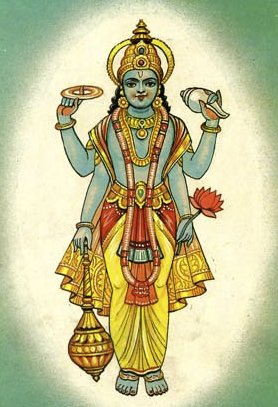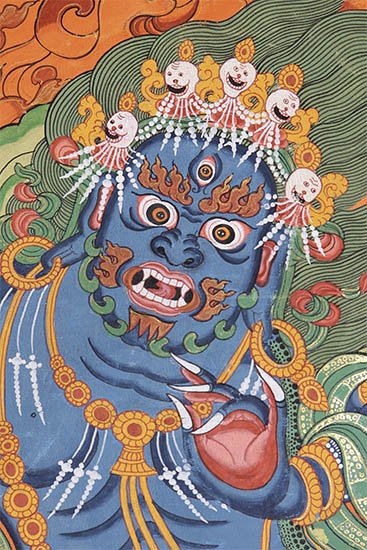Sphurti, Sphūrti: 10 definitions
Introduction:
Sphurti means something in Buddhism, Pali, Hinduism, Sanskrit, Marathi, Hindi. If you want to know the exact meaning, history, etymology or English translation of this term then check out the descriptions on this page. Add your comment or reference to a book if you want to contribute to this summary article.
Alternative spellings of this word include Sfurti.
In Hinduism
Vaishnavism (Vaishava dharma)
Source: Pure Bhakti: Brhad BhagavatamrtamSphūrti (स्फूर्ति) refers to:—Manifestation or temporary vision of transcendental reality. (cf. Glossary page from Śrī Bṛhad-bhāgavatāmṛta).

Vaishnava (वैष्णव, vaiṣṇava) or vaishnavism (vaiṣṇavism) represents a tradition of Hinduism worshipping Vishnu as the supreme Lord. Similar to the Shaktism and Shaivism traditions, Vaishnavism also developed as an individual movement, famous for its exposition of the dashavatara (‘ten avatars of Vishnu’).
In Buddhism
Tibetan Buddhism (Vajrayana or tantric Buddhism)
Source: Brill: Śaivism and the Tantric Traditions (tantric Buddhism)Sphūrti (स्फूर्ति) refers to “quivering (with excitement)”, according to Kuladatta’s Kriyāsaṃgrahapañjikā, a text within Tantric Buddhism representing a construction manual for monasteries.—Accordingly, [vanayātrā in chapter 5]—“When the wood [to be used for the construction of a monastery] or the stones [to be used for the construction of a caitya] are brought into the city, [the Ācārya] should send a message [that these materials are being brought into the city] to the king or the citizens. He should make people with joyful minds whose bodies quiver with excitement (madana-sphūrti-mūrti) carry [these materials]”.

Tibetan Buddhism includes schools such as Nyingma, Kadampa, Kagyu and Gelug. Their primary canon of literature is divided in two broad categories: The Kangyur, which consists of Buddha’s words, and the Tengyur, which includes commentaries from various sources. Esotericism and tantra techniques (vajrayāna) are collected indepently.
Languages of India and abroad
Marathi-English dictionary
Source: DDSA: The Aryabhusan school dictionary, Marathi-Englishsphūrti (स्फूर्ति) [-rta, -र्त].—f The awakening or stirring of a matter reposited in the memory or mind; inspiration. The coming to mind; quivering.
Marathi is an Indo-European language having over 70 million native speakers people in (predominantly) Maharashtra India. Marathi, like many other Indo-Aryan languages, evolved from early forms of Prakrit, which itself is a subset of Sanskrit, one of the most ancient languages of the world.
Sanskrit dictionary
Source: DDSA: The practical Sanskrit-English dictionarySphūrti (स्फूर्ति).—f. [sphurcch-sphur vā ktin]
1) Throbbing, shaking, vibration.
2) Spring, bound.
3) Blooming, opening.
4) Manifestation, display.
5) Flashing on the mind.
6) Poetical inspiration.
7) Bragging, boasting.
Derivable forms: sphūrtiḥ (स्फूर्तिः).
Source: Cologne Digital Sanskrit Dictionaries: Benfey Sanskrit-English DictionarySphūrti (स्फूर्ति).—i. e. sphur + ti, f. Shaking, [Bhartṛhari, (ed. Bohlen.)] 3, 34; throbbing, Windischmann, Sankara, 12.
Source: Cologne Digital Sanskrit Dictionaries: Cappeller Sanskrit-English DictionarySphūrti (स्फूर्ति).—[feminine] appearance, manifestation.
Source: Cologne Digital Sanskrit Dictionaries: Monier-Williams Sanskrit-English Dictionary1) Sphūrti (स्फूर्ति):—[from sphur] f. quivering, throbbing, throb, palpitation, tremor, vibration, [Bhāvaprakāśa]
2) [v.s. ...] breaking forth visibly, sudden appearance or display, manifestation, [Kāvya literature; Rājataraṅgiṇī]
3) [v.s. ...] bragging, boasting, [Pañcadaṇḍacchattra-prabandha]
[Sanskrit to German]
Sanskrit, also spelled संस्कृतम् (saṃskṛtam), is an ancient language of India commonly seen as the grandmother of the Indo-European language family (even English!). Closely allied with Prakrit and Pali, Sanskrit is more exhaustive in both grammar and terms and has the most extensive collection of literature in the world, greatly surpassing its sister-languages Greek and Latin.
Hindi dictionary
Source: DDSA: A practical Hindi-English dictionarySphūrti (स्फूर्ति) [Also spelled sfurti]:—(nf) agility, smartness, quickness; tone; freshness; ~[kāraka/kārī/dāyī] imparting agility/smartness; refreshing.
...
Kannada-English dictionary
Source: Alar: Kannada-English corpusSphūrti (ಸ್ಫೂರ್ತಿ):—
1) [noun] the act or an instance of trembling, shivering.
2) [noun] an act of jumping, leaping or hopping.
3) [noun] a blowing, expanding (as of a flower).
4) [noun] the act of becoming evident or seen clearly.
5) [noun] splendour; great shining.
6) [noun] a thought, idea which flashes in the mind suddenly like a lightning.
7) [noun] an act or process of this.
Kannada is a Dravidian language (as opposed to the Indo-European language family) mainly spoken in the southwestern region of India.
See also (Relevant definitions)
Starts with: Sphurtigedu, Sphurtiman, Sphurtimant, Sphurtimat.
Ends with: Antahsphurti, Asphurti, Daivisphurti, Jivasphurti, Madanasphurti, Mahabhashyapradipasphurti, Mahabhashyasphurti, Parisphurti, Sabhasphurti, Samayasphurti, Vishvasphurti, Visphurti.
Full-text: Sphurtimant, Parisphurti, Vishvasphurji, Vishvasphurti, Sphurtimat, Mahabhashyasphurti, Sfurti, Dipti, Spuriti, Uti, Murti, Madana, Pratibha, Mahabhashya.
Relevant text
Search found 11 books and stories containing Sphurti, Sphūrti; (plurals include: Sphurtis, Sphūrtis). You can also click to the full overview containing English textual excerpts. Below are direct links for the most relevant articles:
Bhakti-rasamrta-sindhu (by Śrīla Rūpa Gosvāmī)
Verse 3.1.18 < [Part 1 - Neutral Love of God (śānta-rasa)]
Verse 2.4.98 < [Part 4 - Transient Ecstatic Disturbances (vyābhicāri-bhāva)]
Verse 1.2.115 < [Part 2 - Devotional Service in Practice (sādhana-bhakti)]
Bhajana-Rahasya (by Srila Bhaktivinoda Thakura Mahasaya)
Text 8 < [Chapter 4 - Caturtha-yāma-sādhana (Madhyāhna-kālīya-bhajana–ruci-bhajana)]
Text 11 < [Chapter 6 - Ṣaṣṭha-yāma-sādhana (Sāyaṃ-kālīya-bhajana–bhāva)]
Text 16 < [Chapter 7 - Saptama-yāma-sādhana (Pradoṣa-kālīya-bhajana–vipralambha-prema)]
Brihad Bhagavatamrita (commentary) (by Śrī Śrīmad Bhaktivedānta Nārāyana Gosvāmī Mahārāja)
Verse 2.1.87 < [Chapter 1 - Vairāgya (renunciation)]
Verse 2.2.214 < [Chapter 2 - Jñāna (knowledge)]
Verse 2.2.28 < [Chapter 2 - Jñāna (knowledge)]
Srila Gurudeva (The Supreme Treasure) (by Swami Bhaktivedanta Madhava Maharaja)
Gurudeva gives everything... < [Chapter 2.12 - Early ISKCON Conversations with Śrīla Gurudeva]
Śrī Ramaṇa-māñjarī-aṣṭakam (visamavṛttena viracitam) < [Chapter 2.18 - Prayers to Śrīla Gurudeva]
Chaitanya Bhagavata (by Bhumipati Dāsa)
Verse 1.2.7 < [Chapter 2 - The Lord’s Appearance]
Verse 1.2.142 < [Chapter 2 - The Lord’s Appearance]
Verse 3.3.512 < [Chapter 3 - Mahāprabhu’s Deliverance of Sarvabhauma, Exhibition of His Six-armed Form, and Journey to Bengal]
Garga Samhita (English) (by Danavir Goswami)
Verse 8.13.16 < [Chapter 13 - A Thousand Names of Lord Balarāma]